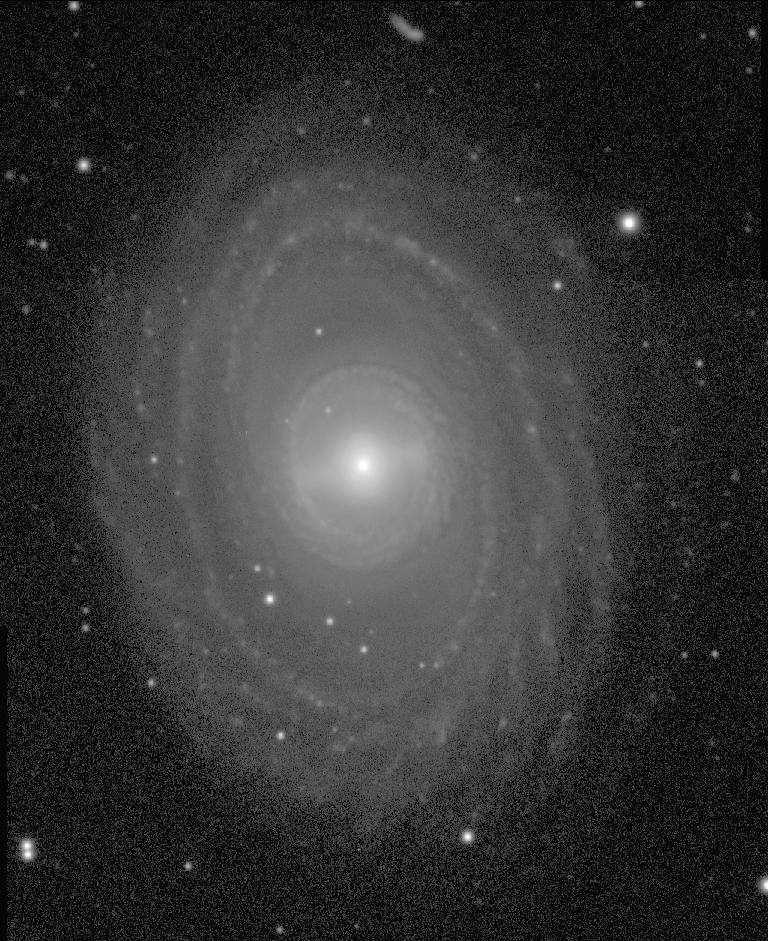

De Vaucouleurs Atlas Type: (R')SB(rs)ab
Filter: B
Telescope: CTIO 1.5-m
North left , East down
Field Dimensions: 7.4 x 9.1 arcminutes
RC3 Type: (R')SB(r)ab
RSA Type: SBab(r)I
Surface Brightness Range Displayed: 17.0-26.0 mag per square arcsec
Absolute Blue Magnitude: -20.6
Elmegreen Spiral Arm Class: AC 6
De Vaucouleurs Atlas Description:
NGC 1398 is a bright early-type spiral with many interesting features, most notably its bright bar and inner ring . Although the inner ring is exceptionally well-defined, it is made of an open two-armed spiral, and we use the underline notation to indicate that it is a nearly closed pseudoring. The ring is exactly filled by the bar along its minor axis; however, in a deprojected image, the ring is actually slightly elongated parallel to the bar axis. It may be more intrinsically circular than the average SB inner ring .
The (R') refers to the appearance of the two bright, thin arms which break from near the ends of the bar. These two arms form a fairly open pseudoring that resembles the OLR subclass (R2'). If this feature really defines the location of the OLR , then in this case there is considerable spiral structure outside that resonance in the form of flocculent spurs. Moore and Gottesman (1995) evaluate this idea but conclude that the implied positions of other resonances (such as UHR or CR ), based on an HI rotation curve, seem inconsistent with expectations in the other parts of the galaxy. Instead, they argue for the bar and spiral in NGC 1398 to have different pattern speeds. The pattern speed in NGC 1398 and other barred galaxies is discussed in more detail by Elmegreen et al. (1996).
The color index map shows that virtually all of the spiral structure in NGC 1398 is defined by star formation. (The dark spot in the center of the color index map is due to slight core saturation in the V-band.) The inner ring is lined by discrete blue knots having a fairly regular spacing. Inside the inner ring, only subtle color differences are seen in the form of weak dust lanes. No star formation is found in this region or in the region between the inner ring and the (R'), a very large area. The map also suggests that NGC 1398 has an R1 component in its outer structure, visible as a diffuse, vaguely evident outer ring lying between the inner ring and the R'. Also recognized by Buta (1995a), the feature is partly lined by star formation and is intrinsically elongated perpendicular to the bar. These characteristics are also reflected in the H-alpha maps of Ryder and Dopita (1993) and Hameed and Devereux (1999), who classify NGC 1398 as a ``Category 1" early-type spiral because it has no HII regions more luminous than L(H-alpha) > 1039 ergs/s.
Not visible in the images is subtle isophote twisting in the bulge region of NGC 1398 . This could signify triaxiality in the bulge following Kormendy (1982). Erwin (2004) summarizes various observations of the central isophotes and places NGC 1398 into an inner disk category, meaning the central isophotes indicate the presence of a nuclear disk. The definition of such a feature is that the measured ellipticity of the inner isophotes is less than that of the outer disk, the inner isophotes approximately match the orientation of the outer isophotes, and there is no secondary bar or nuclear ring.